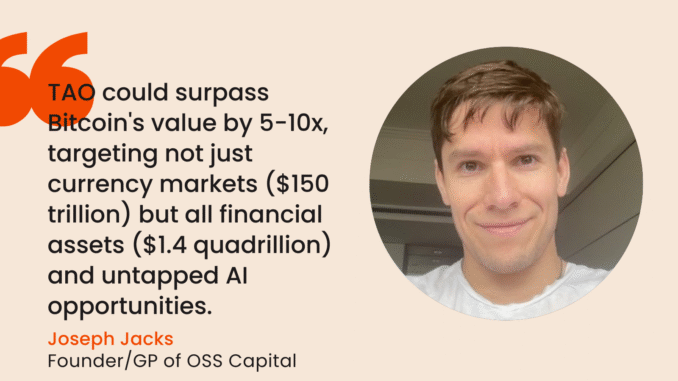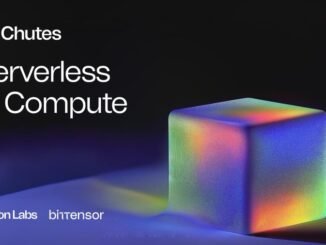
In the rapidly evolving AI space, Bittensor (TAO) stands out as a pioneering force in decentralizing intelligence production. Drawing insights from a July 2025 episode of “The Tao of Pod” podcast, where hosts James Altucher and Bittensor expert JJ discuss the platform’s potential, this article delves deeper into Bittensor’s architecture, subnets, token economics, and its role in democratizing AI. As of September 2025, with TAO trading around $398, recent developments like the launch of Europe’s first physically backed TAO ETP by Safello on August 19 and surging treasury holdings underscore its growing momentum.
What is Bittensor? A Permissionless Network for Digital Commodities
Bittensor is an open-source protocol that incentivizes the creation of valuable digital commodities through a decentralized marketplace. Unlike centralized AI systems controlled by a few corporations, Bittensor leverages blockchain to reward participants for contributing resources like compute power, datasets, and AI models. As JJ explains in the podcast, “Bittensor is transforming and upgrading capitalism” by commoditizing scarce AI ingredients—GPUs, data, algorithms—making them accessible to anyone.
At its core, Bittensor operates on “proof of useful work,” where miners provide real value (e.g., training models or scraping data) rather than just hashing like Bitcoin. Validators assess this work, ensuring quality, and the network distributes TAO tokens accordingly. This creates a self-sustaining ecosystem where global talent and compute converge without monopolistic gatekeepers. The podcast highlights how Bittensor has aggregated around 20,000 GPUs across its network—equivalent to 10-20% of xAI’s Memphis data center—without any capital expenditure on the protocol’s part.
Subnets: Modular Powerhouses Driving Bittensor’s Ecosystem
Bittensor’s innovation lies in its subnet structure—modular sub-networks that function like specialized AI companies. Each subnet focuses on a specific commodity, attracting miners and validators through its own “alpha” token, denominated in TAO. As of September 2025, there were 128 subnets, with 60-70 live; recent activity suggests continued growth, though exact figures remain dynamic.
Key examples from the podcast illustrate their versatility:
– Dataverse (Subnet 13): Rewards miners for producing training data from social sources like Reddit and X. It has amassed 55 billion rows, adding 50 million daily. Developers can access fresh, scraped data to train models—disrupting walled gardens and enabling applications like sentiment-based stock trading. JJ notes, “This subnet produces an incentive for that data to exist as a common open-source commodity.”
– Chutes (Subnet 64): A serverless AI inference platform hosting open-source models like DeepSeek and Hermes. With 4,400 H100 GPUs from miners, it has served nearly 10 trillion tokens to 440,000 users. James demonstrates its ease: Build a customized chatbot (e.g., for a Bible website) at 1/50th the cost of OpenAI, embedding it seamlessly without users knowing about Bittensor.
– Compute Subnets (e.g., Subnet 4 and 51): Offer rentable GPU power, rivaling centralized clouds like AWS. These attract thousands of nodes, with dynamic pricing tied to alpha tokens—far more efficient than traditional stocks. James and JJ mention how data center operators encourage clients to mine here for passive income.
Other subnets cover neural architecture search, agentic AI, and fine-tuning. JJ emphasizes, “You combine that with the training infrastructure, the data, the compute, and the serving… and you’ve got a full platform.” This modularity allows developers to compose tools without building from scratch, fostering innovation for startups, mid-size businesses, and individuals.
Token Economics: TAO as the Fuel for Decentralized Capitalism
TAO, Bittensor’s native token, underpins the ecosystem’s incentives. Miners earn TAO by providing commodities, validators by scoring them, and stakers by delegating to high performers. Alpha tokens on subnets enable price discovery, with the total ecosystem reaching $10-15 billion in fully diluted value just 160 days post the February 2025 “DAL” upgrade.
James views subnets as “AI companies” leveraging Bittensor’s framework: Miners supply resources, validators ensure quality, and users pay in TAO. This creates market efficiencies, turning scarcity into abundance.
JJ predicts TAO could surpass Bitcoin’s value by 5-10x, targeting not just currency markets ($150 trillion) but all financial assets ($1.4 quadrillion) and untapped AI opportunities.
Recent surges in TAO treasury holdings reflect growing confidence, while price predictions vary: Some forecast a drop to $246 by September 8, others highs of $1,239 by month-end. The ETP launch expands accessibility, potentially boosting adoption.
Ownership and Bias: Why Decentralization Matters
Centralized AI inherits creators’ biases—political leanings or data constraints. Bittensor empowers users to own models fully: Train on custom data, control weights, and avoid reliance on APIs that could change. JJ warns, “Your agent will be controlled by them,” contrasting with Bittensor’s user-owned intelligence.
For everyday users, Bittensor abstracts complexities: No need to know about TAO for benefits, as in embedded chatbots. However, the podcast notes friction—e.g., requiring TAO for access—and calls for fiat gateways like Apple Pay.
Future Potential: From Early Internet to Superintelligence
Bittensor is in its “1990s internet” phase: Powerful infrastructure awaiting user-friendly apps. JJ equates it to the internet’s scale, potentially bigger, with subnets as “ingredients” for killer apps. He believes it could achieve superintelligence faster than centralized efforts by harnessing global resources—Bitcoin’s network already dwarfs top supercomputers in compute.
August-September 2025 updates, including treasury growth and ETPs, signal maturation. As James reflects, Bittensor emulates pure capitalism: Connecting suppliers and demand via incentives, scalable infinitely.
In summary, Bittensor isn’t just an AI platform—it’s a new paradigm for collaborative intelligence. As the podcast posits, “Humanity deserves a solution for centralized power monopolies. Bittensor is the solution.” With ongoing developments, it’s poised to redefine how we build and own AI.
Watch the Full TAO Pod EP01 here:




Be the first to comment